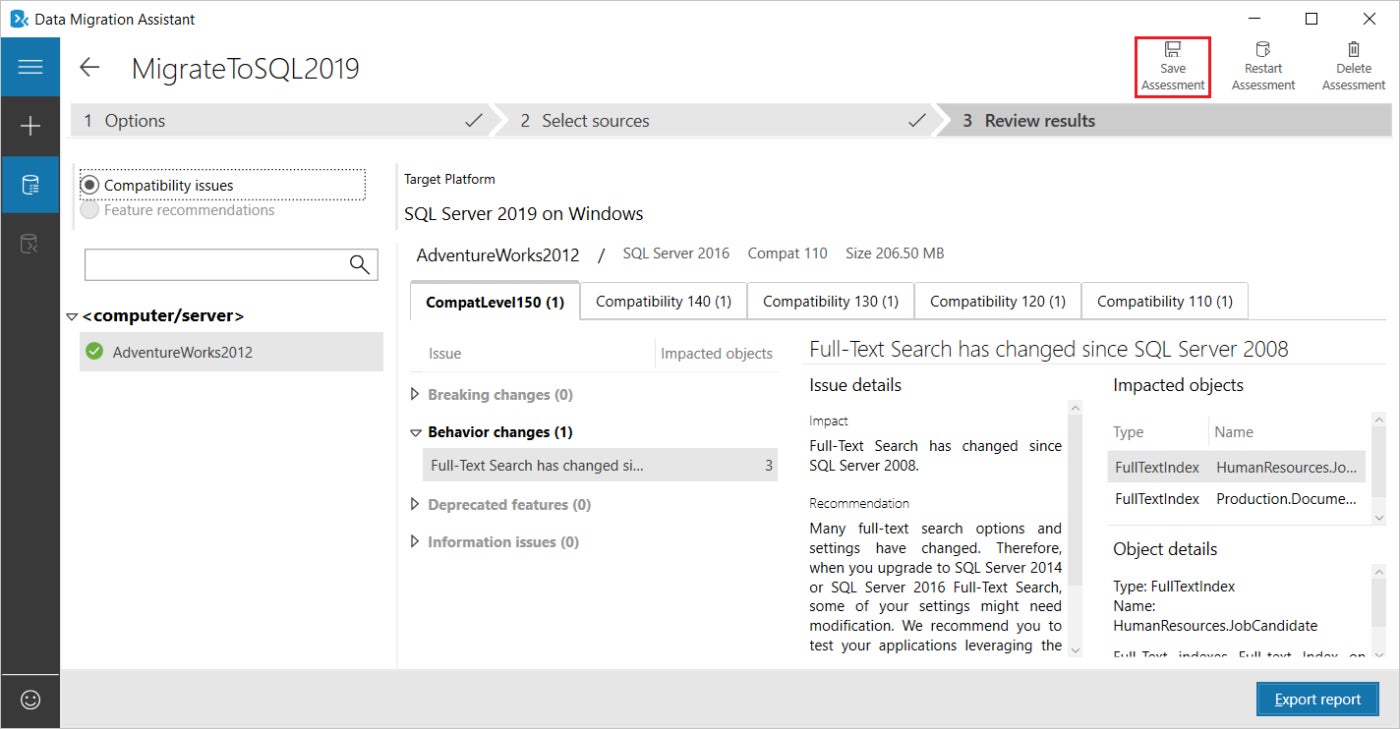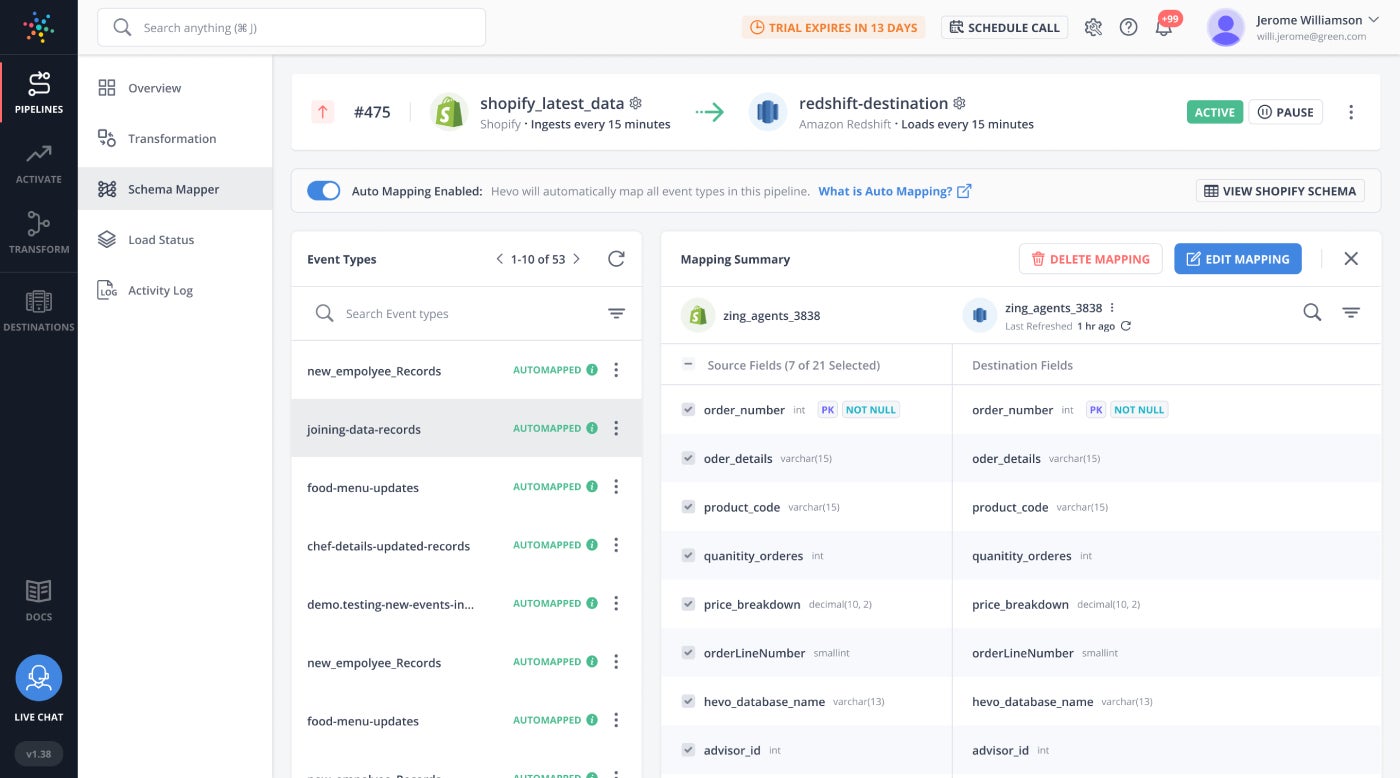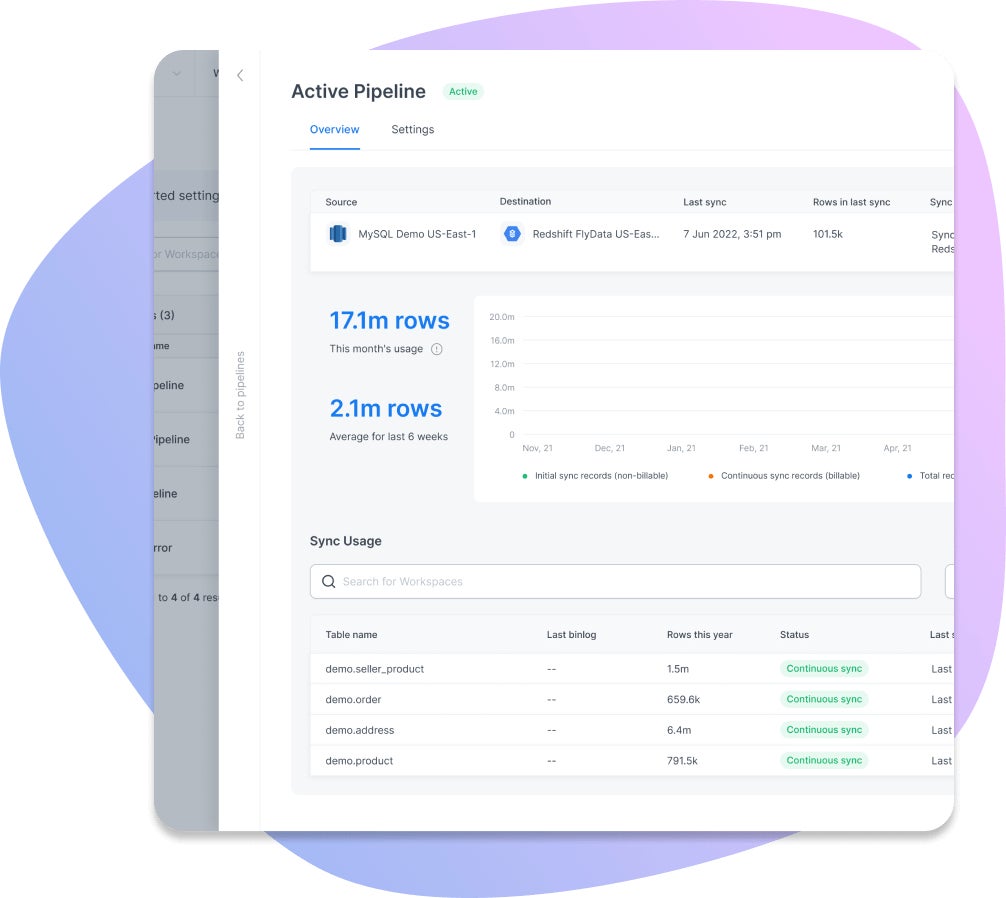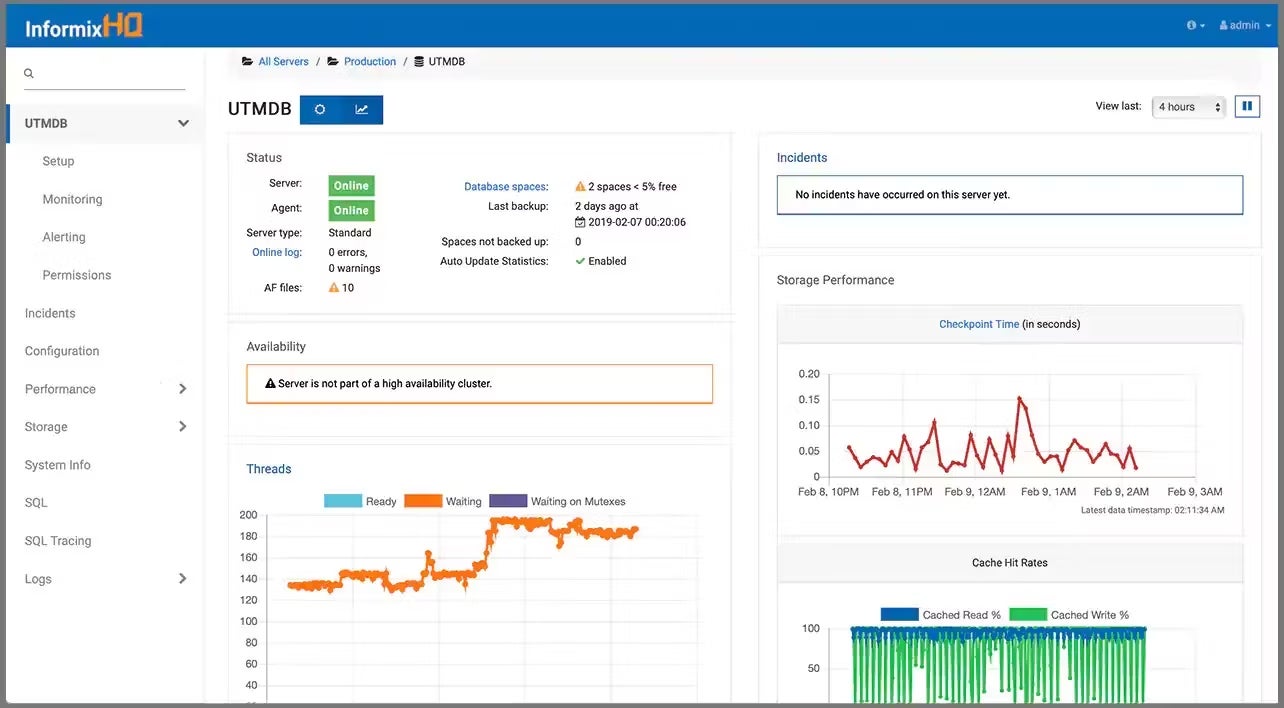- Best for features and advanced functionalities: AWS Database Migration Service
- Best for automated data migration: Fivetran
- Best for data warehouse data migrations: Microsoft Data Migration Assistant
- Best for data migration to new storage: Dell EMC Intelligent Data Mobility
- Best for integration with various data sources: Hevo Pipeline
- Best for prioritizing quality support over cost: Integrate.io
- Best for file conversion and legacy data type translation: IRI NextForm
- Best for ease of use: Stitch Data
- Best for real-time analytics: IBM Informix
- Best for flexible deployment: Matillion
- Best for Mac OS users: Acronis
- Best for Windows user: EaseUS
If you need to move, convert or migrate your data, you’ll need the right tools for the job. Data Migration is a critical process for organizations looking to move or transfer data from one system to another. Data migration tools can automate various data migration and management workflows, offer self-service interfaces to your team and provide other features that make the data migration process more secure and seamless.
In this data migration tools review, we cover some of the top software for businesses of varying sizes and backgrounds.
SEE: Check out TechRepublic Premium’s data migration testing checklist for pre- and post-migration.
Top data migration tools: Comparison chart
| Software | Best for | Supported data targets | Advanced features | Starting price | |
|---|---|---|---|---|---|
| AWS Database Migration Service | Features and advanced functionalities | AWS services, RDS, Redshift | Schema conversion, CDC | Varies based on size of data | Visit AWS |
| Fivetran | Automated data migration | Cloud data warehouses | Automated data connectors | Pay-as-you-go | Visit Fivetran |
| Microsoft Data Migration Assistant | Data warehouse data migrations | Azure SQL Database, Azure Synapse | Schema validation, CLI | $0.37 per hour | Visit Microsoft |
| Dell EMC Intelligent Data Mobility | Data migration to new storage | Cloud platforms, storage systems | Automated data movement | Custom pricing | Visit Dell |
| Hevo Pipeline | Integration with various data sources | Cloud data warehouses | Real-time data integration | $239 per month, billed annually | Visit Hevo |
| Integrate.io | Prioritizing quality support over cost | Data warehouses, cloud platforms | Data mapping, transformations | $159 per month per 5 million rows, billed annually | Visit Integrate.io |
| IRI NextForm | File conversion and legacy data type translation | Various databases, file formats | Data masking, data profiling | $1,000 for current, permanent single-PC version without support | Visit IRI |
| Stitch Data | Ease of use | Data warehouses, cloud platforms | ETL workflows, integrations | $100 per month | Visit Stitch |
| IBM Informix | Real-time analytics | Various databases, platforms | Replication, high availability | Custom quote | Visit IBM |
| Matillion | Flexible deployment | Cloud data warehouses | Data orchestration, ELT | $2 per credit | Visit Matillion |
| Acronis | Mac users | Cloud storage | Backup, disaster recovery | $49.99 per year | Visit Acronis |
| EaseUS | Free PC transfer software | Cloud storage, disks | Disk cloning, backup | $49.95 per month | Visit EaseUS |
AWS Database Migration Service: Best for features and advanced functionalities

Amazon Web Services offers a variety of data migration tool sets, but one of its standout service tools is AWS Database Migration Service. The service allows you to migrate different types of workloads — applications, websites, databases, storage setups and physical or virtual servers — as well as data centers from an on-premises environment, hosting facility or another public cloud environment to AWS.
With this tool, your source database stays active throughout the migration. This reduces downtime for apps that depend on the database and allows you to migrate the database quickly and securely. Furthermore, this service can transfer data to and from the most commonly used commercial and open-source databases.
SEE: Read our full review of AWS DMS.
Pricing
AWS DMS has both free and paid plans. The Free Tier includes up to 750 hours of Single-AZ dms.t2.micro instance usage each month for one year.
The paid plan is available in the following tiers:
- On-demand instances pricing: This plan lets you pay for database migration capacity by the hour with no long-term commitments. For instance, T3 CPU Credits are charged at $0.075 per vCPU-Hour.
- Serverless pricing: This plan allows you to only pay for the capacity you use on a per-hour basis. For instance, one DMS Capacity Unit (DCU) costs $0.087 per hour for Single-AZ and $0.173 per hour for Multi-AZ, while 384 DCUs cost $33.219 per hour for Single-AZ and $66.439 per hour for Multi-AZ.
- Homogeneous data migrations: $0.0824 per migration hour.
- General Purpose (SSD) Storage: It costs $0.115 per GB per month for Single-AZ or $0.23 per GB per month for Multi-AZ.
These rates are not cast in stone — the actual price you will pay for AWS DMS will vary based on the size of the data you are migrating. You can also use the AWS pricing calculator for DMS to create your custom estimate.
Key features
- AWS DMS Fleet Advisor helps automate migration planning, streamline database and analytics fleet transfers to the cloud and suggest optimal migration pathways.
- Provides several ways to transfer files in and out of AWS through online data transfer methods.
- Using the Snow product line, you can transfer data in and out of AWS via offline methods.
- Enables both homogeneous and heterogeneous migrations, which means you can move data between both similar and different database providers.

Pros and cons
| Pros | Cons |
|---|---|
| Supports migration between over 20 databases and analytics engines. | Data type conversion could use some improvement. |
| Highly scalable and easy to set up. | Some users find this tool pricey. |
Why we chose AWS DMS
It supports various database engines, such as MySQL, PostgreSQL, Oracle, SQL Server and others, and it allows users to easily migrate data to AWS databases, data warehouses or data lakes. AWS DMS simplifies the migration process by managing tasks such as schema conversion, data synchronization and ongoing replication.
Fivetran: Best for automated data migration

Fivetran is a cloud-based ETL data migration tool that lets data engineers spend more time generating insights and less time on tedious engineering tasks. With connectors that deploy in a few minutes, automatically adapt to source changes and require zero maintenance, Fivetran simplifies data migration by automatically taking care of all data integration tasks.
In addition, it enables users to centralize and streamline their data operations, including database and application integration, process orchestration and metadata management.
SEE: Read our full review of Fivetran.
Pricing
Fivetran offers a usage-based pricing model, meaning you will only pay for the monthly active rows (MAR) you use each month. It offers a 14-day free trial, allowing you to try the tool before making a purchase decision.
- Free plan: Free for unlimited users and up to 0.5 M monthly active rows.
- Starter: This plan is ideal for small teams with up to 10 users.
- Standard: Designed for fast-growing teams, this plan supports unlimited users.
- Enterprise: Best for large, global teams requiring real-time data delivery and advanced security. This plan supports unlimited users.
- Business critical: For global enterprise teams needing a high level of data protection and compliance. This plan supports unlimited users.
Each plan offers a 14-day free trial, allowing you to try the tool’s features and functionalities before making a purchase decision.
Key features
- Connectors offered for various data sources, including applications, data warehouses, databases, functions, events and files.
- Uses dbt core to monitor pipelines, load data and prompt dbt models to transform data.
- Users can automate and orchestrate their data workflows via the Fivetran dashboard.

Pros and cons
| Pros | Cons |
|---|---|
| Efficient user support representatives. | Connectors don’t offer support for data lakes. |
| Comprehensive documentation. | Some users consider this tool expensive. |
Why we chose Fivetran
Fivetran supports a wide range of data sources and destinations, making it a versatile tool for organizations looking to streamline their data processing workflows. With over 400 connectors available, Fivetran simplifies the process of collecting and syncing data from various sources like databases, applications and cloud services to data warehouses, data lakes and other analytical tools.
Microsoft Data Migration Assistant: Best for data warehouse data migrations

Data Migration Assistant, or DMA, is a tool from Microsoft that enables you to upgrade your database schema and data from a source SQL Server environment to a target SQL Server environment. With this migration tool, you can move schema, data and uncontained objects from your source server to your target server.
The best part about using this tool is that it will help you identify compatibility issues that may impact functionality in your new SQL Server database version. DMA automates database migration, while simultaneously maintaining minimal downtime. It also provides support for Microsoft SQL Server, MySQL, PostgreSQL and MongoDB migration to Azure from on-premises and other cloud environments.
Pricing
The tool is available in two versions:
- Standard compute: This pricing tier offers 1-, 2- and 4-vCore options (a vCore represents a logical CPU) and is generally available and free to customers. This is ideal for small to medium-sized business workloads and only supports offline migration.
- Premium compute: It offers 4-vCore at $0.37 per hour. This plan is ideal for large or business critical workloads. It supports online migrations, offline migrations and faster migration speeds.
You can use the DMS Premium 4-vCore for free for six months or 183 days before incurring any charges. Your free usage time is calculated from the DMS service creation date.
Key features
- Ability to analyze on-premises SQL Server instances migrating to Azure SQL database(s).
- Identifies and resolves compatibility issues blocking migration from on-premises SQL Server database(s) to Azure SQL Database(s).
- Identifies partially supported or unsupported features used on the source SQL Server instance.
- Detects issues, such as behavior changes and deprecated features, that may affect migration to an on-premises SQL Server.

Pros and cons
| Pros | Cons |
|---|---|
| Fast migration process. | The interface could be improved. |
| Highly scalable and adaptable. | First-time users may need to invest more time in learning how to use the tool. |
Why we chose Microsoft Data Migration Assistant
The tool provides a comprehensive report detailing potential issues, such as database objects and features that may not be supported in the target environment. DMA also helps users migrate their databases by providing recommendations and step-by-step guidance throughout the migration process.
Dell EMC Intelligent Data Mobility: Best for data migration to new storage

With Dell EMC Intelligent Data Mobility, users can manage workloads and data migration by leveraging technology, automation and Dell EMC expertise.
This solution is built on modern architecture that delivers a flexible design. It also integrates seamlessly into current business needs, with comprehensive coverage from capture to consumption. This provider’s methodology is built around three pillars: discovery, planning and execution.
Pricing
The pricing for this product is not publicly advertised on the vendor’s website. Buyers are encouraged to contact the vendor for a custom quote.
Key features
- Data migration in discovery, planning and execution phases.
- Extensive automations and workflows.
- Support for remote data transfer of up to 35 TB, across up to 15 Hosts and 15 LUNs per host.

Pros and cons
| Pros | Cons |
|---|---|
| Offers in-region and remote resources. | Documentation could be improved. |
| Highly customizable. |
Why we chose Dell EMC Intelligent Data Mobility
This tool can help minimize downtime during data migration by utilizing intelligent automation and orchestration capabilities. This allows businesses to maintain optimal productivity and avoid disruptions.
Hevo Pipeline: Best for integration with various data sources

Hevo is a cloud-based, no-code data migration platform that simplifies migration from legacy platforms to modern data storage solutions. Users can replicate data from over 150 connectors and migrate it into databases, data warehouses and other analytic tools such as Hadoop, SQL Server and Amazon Redshift.
Hevo specifically allows you to preload transformation and overrides auto schema mapping. With this feature, you can leave the app to do its own tweaking to get your data ready for migrations. With a suite of features aimed at speeding up your processes and saving time, Hevo also allows you to monitor your workflow to resolve any issues before they disrupt business operations.
SEE: Read our full review of Hevo.
Pricing
Hevo Pipeline offers three pricing tiers. The amount you will pay depends on your desired features and the number of events.
- Free: At no cost for up to five users per month. It includes 1 million free events and 50 selected connectors.
- Starter: The amount you will pay for this plan depends on the monthly events you will run.
- 5 million events: $239 per month when billed annually, or $299 per month when billed monthly.
- 20 million events: $399 per month when billed annually, or $499 per month when billed monthly.
- 50 million events: $759 per month when billed annually, or $949 per month when billed monthly.
- 100 million events: $1,159 per month when billed annually, or $1,449 per month when billed monthly.
- Business: Custom pricing.
Key features
- Supports pre-load and post-load data transformation.
- Automated schema management syncs your data destination regardless of changes in source data.
- Supports three ingestion modes: Log-based, Table and Custom SQL.

Pros and cons
| Pros | Cons |
|---|---|
| Drag-and-drop interface for non-technical users. | Its knowledge resources — documentation and video tutorials — could be improved. |
| Easy setup and configuration. | The pipeline scheduling feature could use some improvement. |
Why we chose Hevo Pipeline
With Hevo, users can easily connect to different data sources (150+), such as databases, SaaS applications, files and streaming services, and set up automated data pipelines without writing any code. Hevo allows you to transform your data before loading it into the destination. You can format data on the go, apply filters and modify the schema.
Integrate.io: Best for prioritizing quality support over cost

Integrate.io is a data migration tool that provides users with a single interface for migrating, transforming and managing data between different applications. This tool helps organizations integrate, process and prepare data for analytics in the cloud. The solution is scalable and cost-effective, with an intuitive interface and a highly automated workflow.
Integrate.io’s ease of use enables users to focus on their business without worrying about the complexities of data migration. Integrations are available via REST API or direct FTP uploads to make it possible for even non-technical personnel to work seamlessly with their technology stack while using this tool.
SEE: Read our full review of Integrate.io.
Pricing
The amount you will pay for this tool depends on your selected plan and desired features.
ETL and Reverse ETL
- Starter: $1,250 per month. Ideal for basic ETL needs and running pipelines.
- Professional: $2,083 per month. Ideal for those with high data security needs and basic ETL needs and for running pipelines.
- Enterprise: Custom pricing. Ideal for companies looking for advanced security, features and support.
ETL and CDC
Pricing for this plan varies based on your data management needs.
- 5 million rows: $159 per month when billed annually, or $199 per month when billed monthly. Overage per million rows will cost you $49.
- 15 million rows: $340 per month when billed annually, or $430 per month when billed monthly. Overage per million rows will cost you $32.
- 40 million rows: $630 per month when billed annually, or $788 per month when billed monthly. Overage per million rows will cost you $22.
- 75 million rows: $1,005 per month when billed annually, or $1,256 per month when billed monthly. Overage per million rows will cost you $15.
- 150 million rows: $1,723 per month when billed annually, or $2,154 per month when billed monthly. Overage per million rows will cost you $13.
- 300 million rows: $2,729 per month when billed annually, or $3,411 per month when billed monthly. Overage per million rows will cost you $11.
- 600 million rows: $3,733 per month when billed annually, or $4,667 per month when billed monthly. Overage per million rows will cost you $9.
DWH Insights
- Essentials: Available for free and includes 30 vCPUs. Additional vCPUs will cost $9 per vCPUs per month.
- Growth: Costs $750 per month and includes 50 vCPUs. Additional vCPUs will cost $14 per vCPUs per month.
- Enterprise: It costs $1,450 per month. Custom vCPUs.
Key features
- Supports over 200 data sources.
- Supports data movement into Hadoop HDFS, MongoDB, SQL Server, Elasticsearch and Redshift.
- Uses REST APIs to connect to any data source.
- Encrypts data at rest.
- Offers round-the-clock customer support.

Pros and cons
| Pros | Cons |
|---|---|
| Responsive support. | The error debugging process could be improved. |
| Easy-to-use and intuitive user interface. | Some users consider the tool pricey. |
Why we chose Integrate.io
Whether you need to migrate data between databases, warehouses, applications or cloud services, Integrate.io can help streamline the process. With support for hundreds of native connectors, including REST APIs, databases and more, you can easily ingest data from a variety of sources.
While Integrate.io does not support trigger-based pipelines, you can schedule ETL pipelines to run at regular intervals (e.g., every 5 minutes) and CDC pipelines for more frequent updates (e.g., every 60 seconds).
IRI NextForm: Best for file conversion and legacy data type translation

IRI NextForm is a data migration tool built on Eclipse. This tool can migrate, reformat, convert, replicate, federate and report data from one system or format to another. In addition, it can move information from legacy systems into new environments and upgrade old database engines and other components that may not have native export capabilities.
SEE: Read our full review of NextForm.
Pricing
This tool’s pricing depends on the edition you need:
- Lite: It’s free for a single Windows PC based on 2018 build, JRE 7, but costs $1,000 for a current, permanent single-PC version without support. If you need support, it charges $125 per file or incident hour or $1K per year for 10 incident hours and upgrades.
- COBOL (Featuring: Lite + Micro Focus libraries): It costs $3,500 for Windows systems, $4,500 for x86 Linux and $5,500 for Unix (AIX, Solaris, HP-UX, MacOS) systems.
- DBMS (Featuring: Lite + ODBC libraries): $5,000 to $25,000, depending on databases and hardware platforms.
- Legacy (Featuring: Lite + Proprietary drivers): Pricing varies based on data sources and hardware platforms.
- Modern (Featuring: Lite + Proprietary drivers): Pricing varies based on data sources and hardware platforms.
- Premium (Featuring: Lite + Multiple libraries): Pricing varies based on data sources and hardware platforms.
Key features
- Able to structure previously unstructured data.
- Remaps data types, record layouts and file formats.
- Built-in report generation.
- Can convert EBCDIC data files (including zoned and PD fields) to ASCII.
- Cross-platform format allows it to run on Windows, Unix and Linux systems.

Pros and cons
| Pros | Cons |
|---|---|
| Converts over 100 data types. | Steep learning curve. |
| Extracts values and metadata from document file formats such as HTML, Microsoft Office and PDF. |
Why we chose IRI NextForm
With NextForm, you can easily migrate data from approximately 200 data sources, including legacy and modern databases, flat files and unstructured text files. The tool offers cross-platform support for Unix, Windows and Linux, making it versatile for various environments.
Stitch Data: Best for ease of use

Stitch Data from Talend is an ETL tool that helps you transform, cleanse and prepare your data so it’s ready for analysis. Stitch can also extract and load structured or unstructured data from various sources, like databases and spreadsheets.
With these capabilities, you can execute your analytical workflow with a single tool. With its diverse connectors, Stitch provides customers with an easy way to migrate their complex databases without coding.
Pricing
- Standard: Starts at $100 per month, or $1,000 per year for five million rows. This plan is available for up to five users.
- Advanced: $1,250 per month, billed annually. It includes 100 million rows per month.
- Premium: $2,500 per month, billed annually. It includes one billion rows per month.
- Stitch Platform: Custom pricing. Ideal for agencies that need client data pipelines in one place.
Key features
- Supports popular databases such as MySQL, PostgreSQL, SQL Server, Oracle and Amazon Redshift.
- Offers over 130 connectors.
- Automates data ingestion.

Pros and cons
| Pros | Cons |
|---|---|
| Easy to set up and configure. | The user interface could be improved. |
| Not as expensive as many competitors. | Steep learning curve. |
Why we chose Stitch Data
Stitch Data is designed to be user-friendly and requires no coding to set up and use. It helps organizations consolidate their data from various sources into a central data warehouse for analysis and reporting.
IBM Informix: Best for real-time analytics

IBM Informix is a Data Migration solution that works with SQL commands and migrates data from one IBM Informix database or operating system to another.
Integrating SQL, NoSQL, JSON, time-series and geographic data is made simpler with IBM Informix’s migration tool. It also has an intuitive GUI that simplifies workflows, allowing users to migrate data between various database types and platforms.
SEE: Read our full review of IBM Informix.
Pricing
Contact the vendor for custom pricing.
Key features
- Offers self-management and automated administrative capabilities for edge, cloud and on-premises analytics.
- Real-time analytics.
- Automated data management.
- Offers high availability data replication.

Pros and cons
| Pros | Cons |
|---|---|
| High scalability and availability. | Platform tends to be slow during big data transfers. |
| The setup process is relatively simple. | Some users find the tool pricey. |
Why we chose IBM Informix
IBM Informix is designed to handle large volumes of data and is optimized for high-speed transaction processing and support complex data types. It provides advanced features such as data replication, high availability and security enhancements. It is used by organizations in various industries, including finance, healthcare and government.
Matillion: Best for flexible deployment

Matillion is a cloud-based ETL solution that enables you to migrate data between systems, databases and platforms. This tool primarily lets you load, transform, sync and orchestrate data in a centralized location with built-in analytics capabilities.
In addition, Matillion allows users to sync data back to business and operational applications through reverse ETL with pre-built connectors. They can also manage complex pipelines through a single dashboard and customize ETL for organization-specific infrastructure.
Matillion pricing
Matillion offers three pricing plans with different features:
- Basic: It costs $2 per credit and starts with five users.
- Advanced: It costs $2.50 per credit.
- Enterprise: It costs $2.70 per credit.
Matillion features
- Offers low-code/no-code GUI.
- Users can create their own connectors.
- Deploys flexibly with SaaS and hybrid options.
- Supports Amazon Redshift Spectrum, Amazon S3 components, Amazon SNS and SQS alerts.
- Compatible with Azure Synapse-specific functionalities, such as reading from Blob Storage and alerts and notifications through Azure Message Queues.

Pros and cons
| Pros | Cons |
|---|---|
| Drag-and drop-functionality. | Some users consider this tool pricey. |
| Extensive native connectors for different applications. |
Why we chose Matillion
Matillion is used by businesses for data integration, transformation and orchestration to support analytics, business intelligence and machine-learning initiatives. It is popular for its scalability, ease of use and ability to handle large volumes of data efficiently.
Acronis: Best for Mac OS users

Acronis Data Migration is a software solution developed by Acronis that allows users to transfer data from one storage device to another. This tool is often used when upgrading to a new computer or transferring data between computers. It helps users easily and securely migrate their data, including files, programs and settings, to a new device without the risk of data loss or corruption.
Acronis pricing
A 30-day free trial is available.
- Essentials: $49.99 per year for one computer.
- Advanced: $54.99 per year for one computer.
- Premium: $124.99 per year for one computer.
Acronis features
- Migrate your data across various mobile operating systems, from Android to iOS, iOS to Android or between two devices using the same OS.
- Flexible backups — full image to file-level.
- Full data migration for operating systems, boot information, programs and files.

Pros and cons
| Pros | Cons |
|---|---|
| Simple and easy to use. | Support can be improved. |
| Easy and flexible data restoration options in case of data loss or corruption. | Reporting capability can be improved. |
Why we chose Acronis
Acronis Cyber Protect Home Office allows you to transfer data across various platforms, including mobile operating systems like Android and iOS. This flexibility makes it the perfect tool for transferring data between different devices.
EaseUS: Best for Windows user

EaseUS Data Transfer is a software tool designed to help users transfer data, files and applications from one computer to another with ease. It is typically used when setting up a new computer, upgrading to a new device or performing a system migration. It supports multiple types of data, including documents, photos, videos, music, emails and applications.
EaseUS pricing
- Free: Up to 2 GB data transfer.
- Monthly: $49.95 per month. One license for two computers.
- Annual: $59.95 per year. One license for two computers.
- Lifetime Upgrades: $69.95. One license for two computers.
EaseUS features
- Selective data transfer.
- Compatible with Windows Servers.
- Support Windows such as 11/10/8/7/XP.

Pros and cons
| Pros | Cons |
|---|---|
| Fast transfer speed. | The free plan is limited to 2 GB. |
| It can clean up junk files on the system disk or move large files to free up disk space. |
Why we chose EaseUS
The software simplifies the process by providing a user-friendly interface and guiding users through the transfer process step by step. It allows for selective data transfer, so users can choose what specific files or applications they want to transfer.
How to choose the right data migration tool
To choose the right data migration tool, you need to consider your business-specific needs and how much time and resources it will take for your organization to perform the necessary migration tasks. It is also important to remember that some tools can only be used on one type of device, while others can work across all kinds of platforms. A comprehensive tool that supports all platforms is ideal if you’re migrating a mixed environment of server, desktop and mobile device data sources.
SEE: Use this data governance checklist from TechRepublic Premium for your organization.
As far as pricing goes, it usually depends on the number of users in your company and whether you want to use an online or offline solution. Other factors to consider include the file formats you plan to migrate as well as bandwidth constraints. TechRepublic recommends that you shop around and compare products before making decisions. Most importantly, read customer reviews for each product to determine what works for your specific line of business and data needs.
Review methodology
We researched hundreds of data migration tools and narrowed down our list to the best 12 in 2024. Our top picks balance quality service with moderately expensive or affordable pricing and offer value for money. We gathered primary data about each data migration tool from the vendor’s website.
We also analyzed users’ feedback on reputable review sites like Gartner Peer Insight to learn about current and past users’ experience with each tool. This data was used to create each data migration software product overview, determine what and who each tool is best for, and learn about their features and functionalities, pricing, strengths and weaknesses.
Read next: Explore our list of the top data integration tools.

